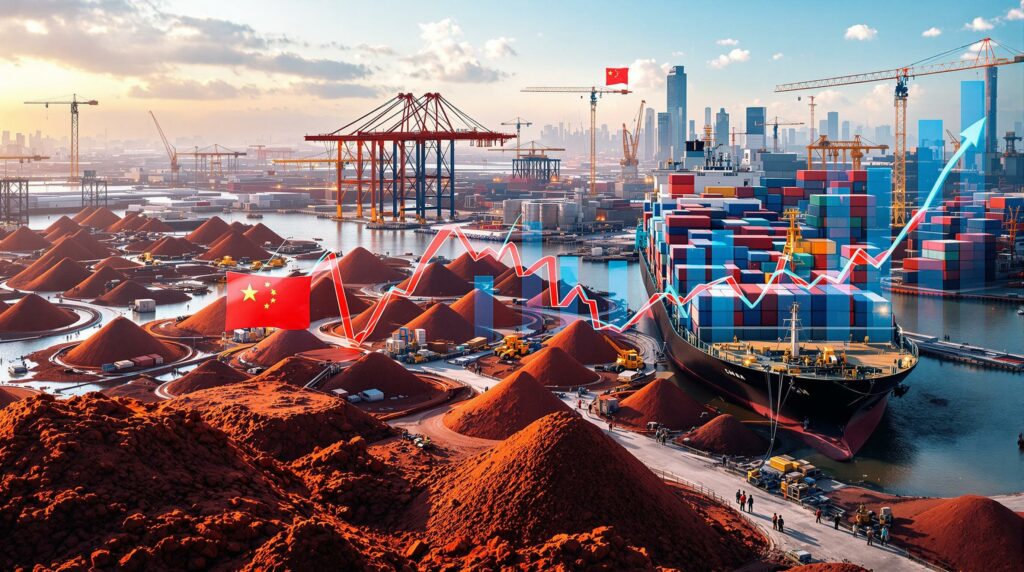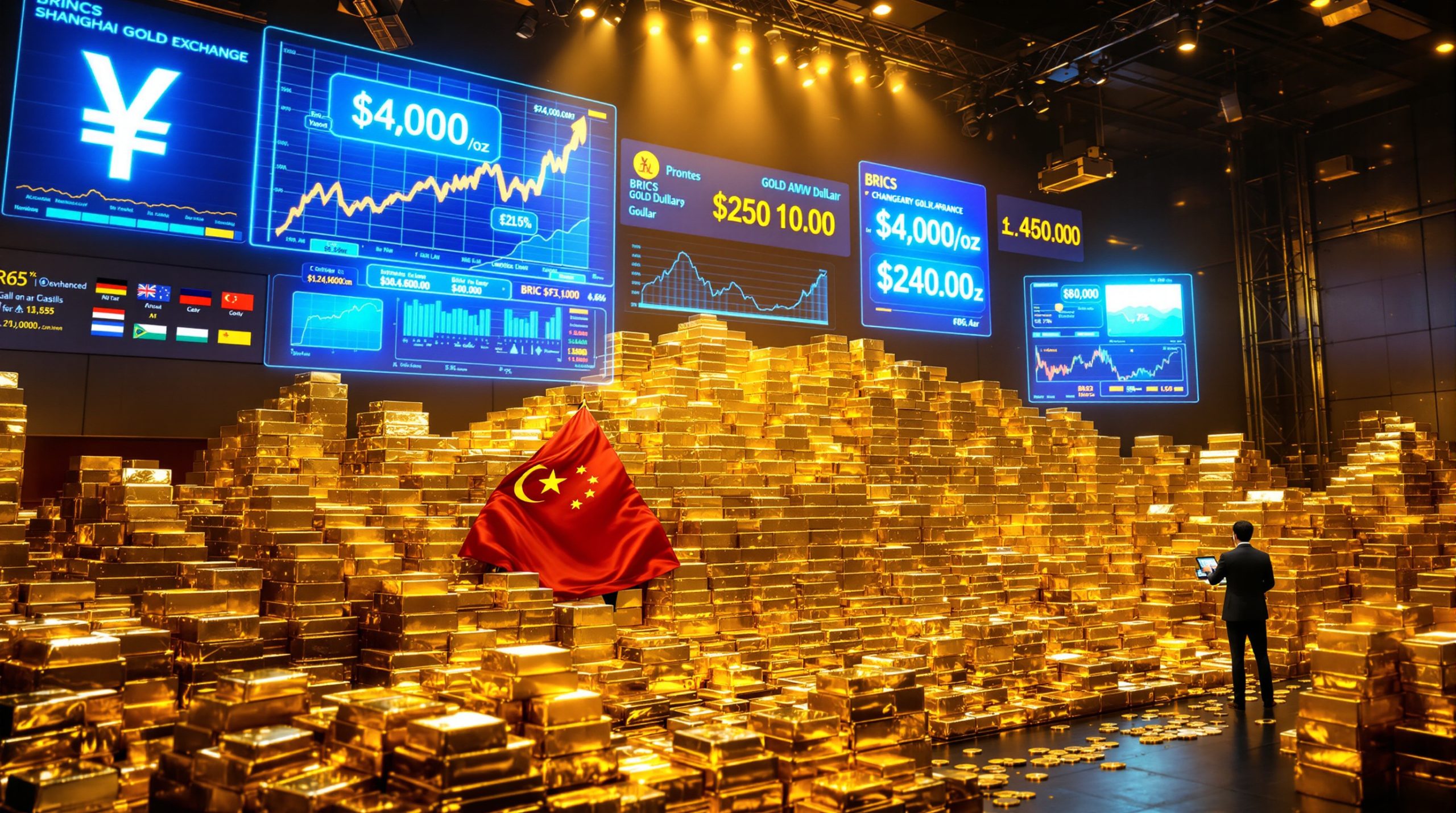China's Iron Ore Demand Shaping Global Markets and Industry Dynamics
China's insatiable appetite for iron ore continues to be the primary driver of global market dynamics, with recent trends showing significant implications for both suppliers and consumers worldwide. The Asian giant's purchasing patterns, influenced by a complex interplay of economic indicators, policy decisions, and steel industry performance, create ripple effects throughout the global commodity market.
Current State of Chinese Iron Ore Demand
Chinese steel mills have recently increased their restocking activities, pushing iron ore futures higher. As of August 2025, the September iron ore contract on China's Dalian Commodity Exchange traded 0.82% higher at 796.5 yuan ($110.89) per metric ton, while the benchmark September iron ore on Singapore Exchange rose 1.32% to $103.45 per ton.
This uptick in purchasing activity comes despite seasonal headwinds, demonstrating the complex factors at play in China's iron ore consumption patterns. Industry analysts point to improved profit margins at steel mills as a key driver behind the current restocking trend.
"Healthy margins and low inventories have led steel mills to restock, contributing to higher iron ore demand trends," noted ANZ analysts in a recent market report, though they cautioned that some gains were tempered by expectations of production cuts in northern China ahead of a military parade scheduled for September 3.
Key Economic Indicators Driving Chinese Iron Ore Consumption
Steel production rates remain a critical indicator of iron ore demand in China. Despite seasonal fluctuations, Chinese blast-furnace steel mills achieved better profits on finished steel sales in July 2025, according to data from Mysteel consultancy. This profitability improvement occurred even as production costs increased, primarily due to the rapid recovery in domestic steel prices.
The construction sector, traditionally China's largest consumer of steel products, continues to experience seasonal challenges. High temperatures and heavy rainfall in many regions have temporarily dampened construction activities, creating short-term fluctuations in demand patterns that savvy market participants monitor closely.
Manufacturing output, particularly in steel-intensive industries like automotive, machinery, and appliances, provides another crucial metric for forecasting iron ore requirements. Recent manufacturing data suggests mixed performance across different sectors, contributing to the complex demand picture.
Factors Influencing China's Iron Ore Purchasing Patterns
Steel Mill Profitability and Purchasing Behavior
Profit margins for Chinese steel producers significantly influence their raw material purchasing decisions. When margins expand, mills tend to increase production and raw material purchases; when margins contract, purchasing typically becomes more cautious and price-sensitive.
Recent data indicates that Chinese blast-furnace operators have seen improved profitability despite rising production costs, creating favorable conditions for iron ore purchases. This profitability buffer allows mills to absorb higher raw material costs without immediately cutting production.
The relationship between steel prices and raw material costs remains delicately balanced. When steel prices rise faster than input costs, mills accelerate purchasing; conversely, when input costs outpace finished product prices, purchasing typically becomes more conservative and strategic.
Inventory Management Strategies
Chinese steel mills employ sophisticated inventory management approaches that significantly impact short-term market dynamics. Low inventory levels at mills can trigger rapid restocking cycles, while high inventories typically lead to more measured purchasing patterns.
The current restocking trend among Chinese mills reflects relatively low on-hand inventories combined with improved profitability, creating conditions for active purchasing despite seasonal headwinds in steel demand.
Port inventory levels provide another crucial metric for market participants. Changes in iron ore stockpiles at major Chinese ports often signal shifts in sentiment and purchasing intent among the country's steel producers. Drawdowns typically indicate active consumption, while rapid builds can signal price decline amid surplus.
Seasonal and Weather-Related Influences
Seasonal factors play a substantial role in China's iron ore consumption patterns. As noted by Hexun futures analysts, "Seasonal declines in consumption persist, with high temperatures and heavy rains significantly impacting downstream construction and resulting in steel inventory accumulation."
The summer months typically see reduced construction activity in many regions due to extreme heat, while the rainy season can further hamper projects. These weather-related constraints create temporary mismatches between steel production and consumption, affecting inventory levels and purchasing patterns throughout the supply chain.
Transportation and logistics also face seasonal challenges, with weather events occasionally disrupting haulage operations update and inland transportation networks, creating additional complexity in the iron ore supply chain.
Chinese Policy Decisions Affecting Iron Ore Markets
Environmental Regulations and Production Restrictions
Production curtailment measures in northern China continue to influence iron ore demand patterns. The upcoming military parade scheduled for September 3, 2025, is expected to trigger temporary steel production cuts in the region as authorities implement air quality control measures.
These short-term restrictions represent a recurring pattern in China's industrial policy framework, where environmental and air quality concerns frequently lead to temporary production limitations, particularly around significant national events and during winter heating seasons.
The geographical concentration of these restrictions in northern provinces, which account for a substantial portion of China's steelmaking capacity, means their impact on national iron ore consumption can be significant, though often temporary.
Economic Policy Shifts
China's broader economic policy direction, particularly regarding infrastructure investment and real estate market support, provides critical context for iron ore demand forecasts. Infrastructure projects typically require substantial quantities of steel products, creating direct demand for iron ore.
The real estate sector, despite facing challenges in recent years, remains a major consumer of steel products. Policy adjustments affecting property development directly impact steel consumption patterns and, by extension, iron ore demand.
Industrial policy initiatives targeting manufacturing upgrades and capacity optimization also influence long-term iron ore requirements. Policies promoting higher-value steel production can alter the mix of iron ore grades in demand, while efficiency mandates may reduce the overall volume required per unit of steel output.
Price Dynamics in the Iron Ore Market
Recent Price Movements and Trends
Recent price movements across key trading venues highlight the market's responsiveness to Chinese demand signals. Beyond the previously mentioned price increases on the Dalian Commodity Exchange and Singapore Exchange, related commodities have shown sympathetic movements.
Coking coal futures rose 2.99% and coke futures increased 1.97% on the DCE, reflecting the interconnected nature of steelmaking raw materials. Meanwhile, on the Shanghai Futures Exchange, rebar increased 1.09%, hot-rolled coil climbed 1.29%, wire rod edged up 0.17%, and stainless steel strengthened 1.38%.
These synchronized price movements demonstrate how sentiment regarding iron ore demand in China ripples through related commodity markets, creating correlated price patterns across the steelmaking value chain.
Supply-Side Influences on Pricing
Major producer output levels and export volumes continue to influence price formation in the iron ore market. Supply disruptions, whether due to operational challenges, weather events, or logistics constraints, can create temporary price spikes even when demand remains relatively stable.
Shipping and logistics factors add another layer of complexity to the supply equation. Vessel availability, port congestion, and freight rates all influence the delivered cost of iron ore to Chinese ports, affecting price competitiveness among different supply sources.
Production discipline among major miners represents a key factor in market balance. Major iron ore producers' capital expenditure and output decisions significantly impact medium-term supply forecasts and price forecast insights.
Demand-Side Factors Affecting Prices
Steel inventory accumulation patterns provide important signals about the balance between production and consumption. As noted by market analysts, recent weather-related constraints on construction activity have contributed to steel inventory builds, creating potential downward pressure on steel prices if not quickly absorbed when seasonal conditions improve.
Downstream construction and manufacturing activity levels directly impact steel consumption and, by extension, iron ore requirements. The pace of infrastructure project implementation and property construction progress are particularly important metrics for forecasting near-term demand.
Export market conditions for Chinese steel products add another dimension to the demand equation. Strong export markets can absorb domestic production surpluses, supporting steel prices and iron ore demand even when domestic consumption temporarily weakens.
China's Steel Industry Performance Affecting Iron Ore Demand
Steel Production Metrics and Trends
Blast furnace utilization rates provide a real-time indicator of iron ore consumption. While comprehensive current data wasn't available in the source material, industry reporting typically tracks capacity utilization across major steelmaking regions, with particular attention to environmental restriction impacts in northern provinces.
Regional production differentials are becoming increasingly important as environmental policies and energy availability create varying operating conditions across China's steelmaking regions. Coastal areas typically benefit from easier access to imported raw materials, while inland regions often face higher logistics costs but may have other competitive advantages.
Production cost structures continue to evolve with changes in raw material prices, energy costs, environmental compliance requirements, and labor expenses. These cost factors directly influence mills' profitability and their ability to absorb higher iron ore prices.
Steel Product Pricing and Profitability
Price trends across major steel products have shown recent strength, with futures contracts for key products like rebar and hot-rolled coil posting gains on the Shanghai Futures Exchange. These price increases have outpaced rising production costs, supporting mill profitability despite higher raw material expenses.
The relationship between raw material costs and finished steel prices remains dynamic, with mills constantly navigating the balance between input costs and output pricing. When steel demand is robust, mills can typically pass through higher raw material costs; when demand weakens, margin compression often occurs.
Export Market Dynamics
Chinese steel export volumes and destinations significantly impact domestic market balance and, consequently, iron ore demand. Recent reports indicate that Japanese steelmakers are facing challenges partly due to "downward pressure on prices due to surge in cheap steel exports from China."
This competitive dynamic in international steel markets can create feedback effects in China's domestic market. Strong export opportunities can absorb production that might otherwise pressure domestic prices, while trade barriers in destination markets can force more volume back into China's internal market.
Outlook for China's Iron Ore Demand
Short-Term Forecast (3-6 Months)
The immediate outlook for China's iron ore demand shows mixed signals. On one hand, improved steel mill profitability and relatively low inventory levels support continued purchasing activity. On the other hand, seasonal construction weaknesses and potential production restrictions around the September military parade may temporarily dampen consumption.
Weather transitions will play a crucial role in the coming months, with the conclusion of the rainy season and extreme heat typically leading to improved construction conditions and stronger steel consumption heading into autumn.
Market Insight: The third and fourth quarters typically see improved construction conditions in many regions of China as temperatures moderate and precipitation decreases, potentially supporting stronger steel consumption and iron ore demand if other economic factors remain supportive.
Medium-Term Projections (1-2 Years)
Infrastructure development pipelines will significantly influence medium-term iron ore requirements. Major projects in transportation, energy, water management, and urban development create substantial steel demand, though the pace of implementation can vary with fiscal policy priorities and economic conditions.
Real estate market recovery prospects remain a key variable in the medium-term outlook. The property sector has faced challenges in recent years, but its fundamental importance to China's economy means policy support measures are likely to continue, potentially stabilizing steel demand from this crucial sector.
Manufacturing sector growth trajectories, particularly in high-value industries like machinery, automotive, and advanced equipment, will influence both the volume and quality of steel required, with corresponding impacts on iron ore specifications and quantities.
Long-Term Structural Trends
Steel industry consolidation and efficiency improvements continue to reshape China's iron ore demand profile. Larger, more efficient producers typically achieve better resource utilization, potentially reducing the amount of iron ore required per ton of steel produced over time.
Scrap utilization represents a significant long-term factor in China's iron ore demand outlook. As China's domestic scrap supply increases from decades of steel use, electric arc furnace steelmaking becomes increasingly viable, potentially reducing reliance on blast furnace production and associated iron ore consumption.
Decarbonization initiatives create perhaps the most significant long-term uncertainty for traditional steelmaking methods. As China pursues its carbon neutrality goals, technologies like hydrogen-based direct reduction may gradually displace some blast furnace capacity, fundamentally altering iron ore requirements.
China's Iron Ore Demand Compared to Global Markets
Comparative Analysis with Other Major Markets
Japan's steel industry provides an instructive comparison to China's situation. Recent reports indicate that Japanese major steelmaking companies are witnessing falling quarterly steel output and could see their lowest annual production since 1968, partly due to competitive pressure from Chinese exports.
This contrast highlights China's dominant position in global steel markets and its consequent impact on iron ore demand patterns. While traditional steel-producing nations like Japan face challenges, China's production volumes continue to drive global iron ore consumption.
European market dynamics present another comparative case, with decarbonization efforts advancing more rapidly than in many other regions, potentially accelerating the transition away from traditional blast furnace production and associated iron ore consumption patterns.
China's Share of Global Iron Ore Trade
China's position as the dominant consumer in global seaborne iron ore trade gives it substantial influence over pricing mechanisms and market dynamics. Major suppliers like Australia and Brazil have developed their production profiles specifically to meet Chinese demand requirements.
Strategic relationships with major supplier nations continue to evolve amid changing geopolitical conditions. These relationships not only affect trade flows but can also influence investment decisions in mining capacity expansion and infrastructure development.
FAQ: China's Iron Ore Market
What is driving the current restocking trend among Chinese steel mills?
The current restocking trend appears primarily driven by a combination of improved profit margins and relatively low inventory positions at mills. Despite seasonal weaknesses in downstream steel consumption, mills have maintained purchasing activity due to their improved financial position.
Seasonal factors are also influencing purchasing decisions, with mills potentially positioning ahead of anticipated demand improvements as weather conditions become more favorable for construction in the coming months.
How do production restrictions in northern China affect iron ore demand?
Production restrictions in northern China, such as those anticipated around the September 3 military parade, typically create temporary reductions in iron ore consumption. However, these effects are often partly offset by increased production in regions not subject to restrictions.
The displacement effect means that while national production may decrease during restriction periods, the decline is typically less than the nominal capacity affected by the restrictions, as other regions may increase utilization to capture market share.
What role does steel mill profitability play in iron ore purchasing decisions?
Steel mill profitability directly influences purchasing behavior through several mechanisms. When margins are healthy, mills typically maintain higher production rates and may build raw material inventories as a hedge against potential price increases.
Conversely, when margins contract, mills become more price-sensitive and may reduce production or draw down existing inventories rather than purchasing at prices they view as unfavorable relative to their finished product prices.
Industry Insight: Steel mills closely monitor the ratio between raw material costs and finished steel prices, with many using specific threshold ratios to guide purchasing decisions. When this ratio moves beyond certain parameters, purchasing behavior typically adjusts accordingly.
What impact do Chinese environmental policies have on iron ore consumption?
Environmental policies affect iron ore consumption through multiple channels. Short-term production restrictions for air quality purposes create temporary demand reductions, while longer-term efficiency mandates and technology requirements gradually alter the resource intensity of steel production.
The geographical impact of environmental policies is particularly significant, with northern production hubs typically facing stricter requirements than facilities in other regions, creating regional disparities in production costs and competitiveness.
Technology adoption for cleaner steel production, encouraged by environmental policies, may gradually alter the specifications of iron ore in demand, with higher-grade ores typically offering environmental advantages through improved energy efficiency and reduced emissions per ton of steel produced.
The Future of China's Iron Ore Market
China's iron ore demand will continue to shape global markets, though structural changes in the country's economy and steel industry will likely alter consumption patterns over time. The evolution of China's property sector, infrastructure development model, and manufacturing base will determine the trajectory of iron ore requirements in coming years.
Environmental considerations, particularly decarbonization efforts, represent perhaps the most significant long-term factor influencing China's iron ore demand outlook. As alternative steelmaking technologies advance and policy support for lower-emission production increases, traditional blast furnace ironmaking may gradually lose market share, with corresponding impacts on miners' demand insights.
Despite these evolving dynamics, China's position as the dominant consumer in global iron ore markets appears secure for the foreseeable future, ensuring its purchasing patterns, policy decisions, and industry developments will remain central to understanding global market conditions.
Want to Profit from the Next Major Mineral Discovery?
Stay ahead of the market with real-time alerts on significant ASX mineral discoveries using Discovery Alert's proprietary Discovery IQ model, which turns complex data into actionable investment insights. Understand why major discoveries can lead to substantial returns by exploring Discovery Alert's dedicated discoveries page and begin your 30-day free trial today.




